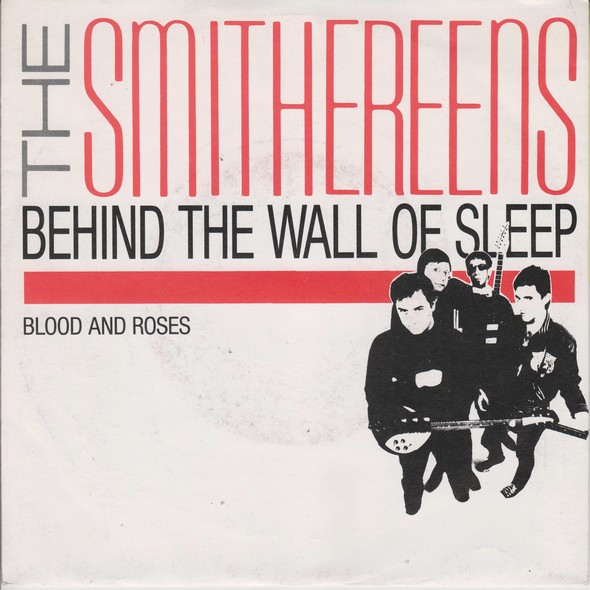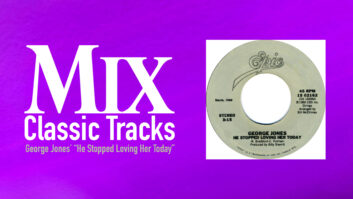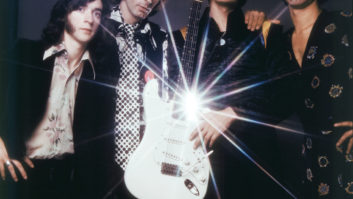Pat DiNizio—The Smithereens’ late, great frontman and principal songwriter—drew inspiration from eclectic sources. For this month’s Classic Track, “Behind the Wall of Sleep,” from the album Especially for You (1986, Enigma), DiNizio rejiggered the title of an H.P. Lovecraft short story, “Beyond the Wall of Sleep.” However, the content of the song bears no resemblance to Lovecraft’s macabre science fiction; “Behind the Wall of Sleep” reveals a fan’s romantic passion for a beautiful bass player, who DiNizio patterned after The Bristols’ Kim Ernst.
 “We’d done a gig with The Bristols, four fabulous women who looked, sounded and dressed like Roger McGuinn’s The Byrds,” DiNizio told Forbes’ Jim Clash in 2015. “Kim had black hair, really long: ‘She [had hair like] like Jeannie Shrimpton back in 1965, she had legs that never ended, I was halfway paralyzed. She was tall and cool and pretty, and she dressed as black as coal. If she asked me to I’d murder, I would gladly lose my soul.’ Our first two hits were ‘Blood And Roses,’ about suicide, and this one, ‘If you’d ask me to I’d murder’—very dark material [laughs].”
“We’d done a gig with The Bristols, four fabulous women who looked, sounded and dressed like Roger McGuinn’s The Byrds,” DiNizio told Forbes’ Jim Clash in 2015. “Kim had black hair, really long: ‘She [had hair like] like Jeannie Shrimpton back in 1965, she had legs that never ended, I was halfway paralyzed. She was tall and cool and pretty, and she dressed as black as coal. If she asked me to I’d murder, I would gladly lose my soul.’ Our first two hits were ‘Blood And Roses,’ about suicide, and this one, ‘If you’d ask me to I’d murder’—very dark material [laughs].”
The Smithereens worked long and hard for the chance to record their first record. In fact, the band had been together for several years before DiNizio even joined. The original members—drummer Dennis Diken, guitarist Jim Babjak and bass player Mike Mesaros—were high school friends who formed a band, and they met DiNizio through an ad.
“Our first EP was called Girls About Town,” says Diken. “It came out around Halloween of ’80. Then by ’82, after playing around the TriState area a lot, we were ready to record another EP, Beauty and Sadness, and we got a lucky break and were able to record at the Record Plant [New York City]. We were thrilled to work in those hallowed halls, and our engineer for the sessions was Jim Ball.”
The band’s opportunity to work in the Record Plant came partly via networking with musicians they knew through playing clubs like Kenny’s Castaways and Folk City. “We also saved up gig money to pay for our studio time: blood money,” Diken says.
Beauty and Sadness didn’t hit to where the players could give up their day jobs, but it got some attention from critics. The Smithereens kept at it, and in 1985 they scheduled more time with Ball at Record Plant.
BACK TO RECORD PLANT NYC
“Those sessions actually almost didn’t happen,” Diken explains. “We had recorded Beauty and Sadness in Studio B. That was the room where Springsteen recorded The River, and a lot of other big stuff was done there. Studio A was also famous for historic sessions; John Lennon worked there. But we were the low guys on the totem pole, so we got a call on the afternoon of Good Friday 1985—when we were supposed to go in that night—saying, ‘Sorry, but we have a more important session booked in B now. We’re going to have to kick you upstairs to C,’ which was a much smaller room.
“We got on the phone with each other and said, ‘Hey, this ain’t too cool. Maybe we should wait until larger rooms become available again,’” he continues. “But in the end, reluctantly, we went for it.”
The band members may have felt unsure, but their engineer had their backs. Jim Ball—whose credits include John Lennon, Aerosmith and Bob Dylan—had come up through the system at Record Plant, graduating from carpenter’s assistant to tape op to assistant before he began engineering and co-producing sessions.
“I actually helped build Studio C,” Ball says. “It was a great studio—really tight. All of our monitors at Record Plant were Westlakes, and all those rooms sounded good.”
The band came into Studio C with five songs to record: “Behind the Wall of Sleep,” “Blood and Roses,” “Alone at Midnight,” “Cigarette,” and “Crazy Mixed Up Kid,” and they laid down basics for all five that night.
“We were cutting everything live, with Pat cutting a scratch vocal in the control room with Jim,” Diken recalls. “We worked quickly, but we poured our hearts and souls into those songs, and we forked some lightning that night.”
THE RECORD PLANT SETUP
Ball recorded the band to an Ampex 1200 24-track tape machine, through Studio C’s custom API console.
He put up Shure SM57s on Babjak’s Fender guitar amp, and took Mesaros direct as well as via an Electro-Voice RE20 microphone on the bass amp. “Jimmy says he played a Les Paul that he found hanging around the studio, with Jim Ball’s permission, for ‘Wall of Sleep,’ feeling it would give the song a tougher, heavier feel,” Diken recalls. “The amp was most likely a Marshall.”
Diken’s drum kit was captured via an AKG D112 on kick, Sennheiser 421s on toms, 57s on snare top and bottom, Neumann U87s overhead, and a Sennheiser 451 pencil mic on hi-hat.
Ball recalls that, though he used fairly standard go-to miking schemes, he and assistant engineer Frank Pekoc would play with the mic placements on guitars, for example, to find sweet spots. “Then we would keep moving things around to get the balance that we liked,” the engineer says. “It was the same with drums. If I didn’t like the bass drum sound, I would move the mic in, move it out, change the blanket.
“On my track sheet, I did things the Record Plant way,” Ball continues. “I’d have bass drum on [track] 16, snare on 15, a couple of guitars on 1 and 2, and bass on 5 and 6. Everybody in the Record Plant used the same track layout. We would put the drums in the middle of the 24-track tape; I think part of the theory was you get the least amount of degradation. A tape that came in from the outside world would have the bass drum on the first track, but we did things differently.
Classic Tracks: Neil Young, “Rockin’ In The Free World”
“We didn’t use much outboard gear [on The Smithereens]—we’d use the EQs in the console. I liked the 550a parametrics on guitars, but I would use 560 graphics on bass and drums,” Ball says. “I also used a Record Plant trick that I learned from Jay Messina; he used it in all the jingles we did and Aerosmith records. We put an 1176 across a bus, and then bus some of the drums into there and limit them. The idea was to get the attack and release to work with the tempo of the song, so you got something extra pumping. You would try to smash the drums a little bit, and that would make them really breathe.”
After basic tracking in Studio C, Ball worked with the band to overdub additional guitar and percussion parts, backing vocals, and in some cases, a new lead vocal by DiNizio. “Behind the Wall of Sleep” also featured a piano part by Joe Kernich.
“Then we took those tracks and we shopped them to every conceivable major and indie label,” Diken says, “and we got turned down by almost everybody. We were crestfallen, because we thought we had some magic in those tracks. Then, finally, we got accepted by Enigma Records. Scott Vanderbilt [A&R] was familiar with our independent EPs from his college radio days, and he liked what he’d heard. I’ve often half-jokingly said that, at that point, Pat was getting so frustrated sending press kits to all these labels, he decided just to send it without a photo; so maybe we got signed because they didn’t know what we looked like.”
BRING IN THE PRODUCER
The five tracks that The Smithereens shopped to Enigma then became the first five tracks on what would become Especially for You. But the band still had work to do, and not surprisingly, their new label wanted them to have a dedicated producer. Enter musician/producer Don Dixon, whose work on R.E.M.’s early albums Murmur and Reckoning had made him one of the hottest alt-rock producers at the time.
“Pat asked me if I would produce them, and I wasn’t sure,” Dixon says. Then one night that Dixon was going to be playing at the Folk City Club, it so happened that The Smithereens were also planning to meet there to sign their Enigma deal.
“The band showed up with a photographer from Billboard and took a photo of us all together backstage,” Dixon says. “The next thing I knew, there was a little blurb in Billboard that I was producing their next record. Once I started working with them, I was delighted that I’d been tricked into it! Pat was such an interesting singer and specific songwriter; the ideas were so wellformed. The images in ‘Behind the Wall of Sleep,’ in particular, are so clear.
“We had a minuscule budget,” Dixon continues. “My work on the whole record was probably a grand total of five days between Christmas and New Year’s of ’85. It was nonstop, too, because there were guests on that album—Suzanne Vega sang backgrounds on ‘In a Lonely Place,’ for example—but ‘Behind the Wall of Sleep’ is one of the more band-focused songs.”
With Dixon, the band recorded the remaining tracks, added more overdubs to the existing five songs, then mixed the entire album.
“I remember that at one point with Don, we were doing overdubs for ‘Behind the Wall of Sleep,’” Ball says. “We were looking for tracks to use, and he asked, ‘What’s ‘Limited Drums?’ It was the bus with the 1176 that I mentioned earlier. He said, ‘Can we get rid of that and do that later in the mix?’ but after he listened to it more, he agreed that it made a big difference, and we kept that on the rock ’n’ roll songs like ‘Behind the Wall of Sleep’ and ‘Blood and Roses.’
“During the mix, we also used a great pair of Drawmer compressors that Don brought in,” Ball adds. “They had just come out. I don’t remember whether we just limited the drums with those or used them on the whole mix, but I think the combination of those compressors with the limited drums made that song very even across the frequency range and very full-sounding. Those elements really add to the character of those songs. I’m very proud of the way those songs turned out, and ‘Behind the Wall of Sleep’ is still my favorite Smithereens song. I put that song up whenever I’m test driving a new pair of speakers.”
“Behind the Wall of Sleep” became the second single released from Especially for You, and it peaked at Number 23 on Billboard’s mainstream rock chart. Having finally achieved some deserved success, The Smithereens recorded their next album, Green Thoughts, with the same production team at Capitol Studios in L.A.
Though Pat DiNizio sadly passed away in 2017, “Forty years later, the band continues,” Diken says. “We’re planning to get back into the studio in 2020. We have been working with Marshall Crenshaw as a guest vocalist and with Robin Wilson from Gin Blossoms. In fact, this past weekend we did two shows—one with Robin and one with Marshall—and our audiences are supportive as can be.”






